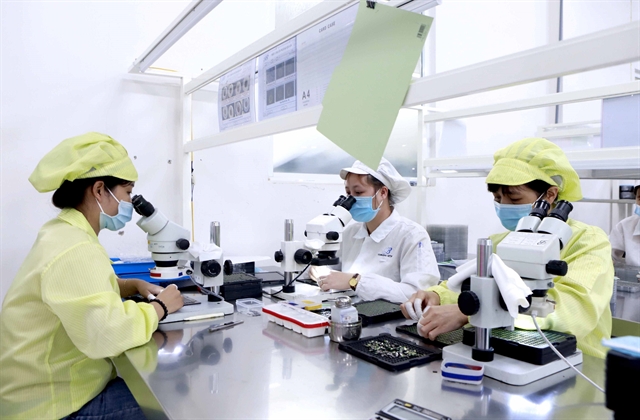 Economy
Economy

 |
| Electronic components produced at Youngbag Việt Nam in Vĩnh Phúc Province. The electronics industry of Việt Nam has a great opportunity to participate in the global supply chain amid a production shift. — VNA/VNS Photo Hoàng Hùng |
HÀ NỘI — It is critical for the electronics industry to enhance its resilience against global shocks, take the opportunities arising from global production and participate deeply in the global supply chain.
At a conference about Industry 4.0 held on Wednesday in Singapore, Đỗ Thị Thuý Hương from the Vietnam Electronic Industries Association (VEIA), said the COVID-19 pandemic and geopolitical conflicts were reshaping the global supply chain during the past three years.
From the beginning of this year, a number of heavyweights in the electronics industry’s supply chain were looking to move to Việt Nam, which would provide significant opportunities for Vietnamese enterprises to participate in the global supply chains and increase added value.
Hương also pointed out that there were opportunities to increase exports to highly demanding markets and expand to new markets thanks to the adjustments in supply chains. Besides, the global production shift also brought opportunities for Việt Nam to attract high-quality foreign direct investment (FDI) in the electronics industry, especially in chip production.
New-generation free trade agreements (FTAs) were also creating favourable conditions for trade and investment.
Challenges were ahead, however, requiring Việt Nam to adjust policies for enterprises and attract FDI to direct the capital flow into high technology sectors and sectors which would create a spillover effect for the Vietnamese economy.
The fourth industrial revolution was also forcing Việt Nam to switch to innovation–driven growth, she said, stressing that cheap labour or available resources were no longer advantages.
Hương also pointed out that Việt Nam lacked a skilled labour force for the electronics industry, which hindered the domestic industry in keeping pace with the development of the global electronics industry.
The technology transfer remained limited because of the capacity of enterprises in terms of human resources and infrastructure, she said.
Vietnamese electronics enterprises must improve their capacity to be able to grab the opportunities, Hương stressed.
Darren Seah from the Industrial Transformation Asia – Pacific (ITAP) said that Vietnamese electronics enterprises had significant opportunities to participate in the global supply chain as there was a tendency to look for new production sites away from traditional markets.
Việt Nam attracted large electronics groups such as Samsung, LG, Intel and Canon and the country could become an electronics production hub of the region, he said.
As the global consumption demand was forecast to drop this year, resulting in falling demand for high-tech items, which would affect the electronics industry.
Experts said that major challenges were the risk of supply chain disruptions and the shortage of human resources.
In that context, enterprises should pay attention to the rapid development trends of digital economy, green finance and green transition, Hương said.
Electronics was the sector with the highest export revenue in the manufacturing industry during the past 10 years.
VEIA’s statistics showed that the electronics industry earned export revenue of more than US$114 billion in 2022, accounting for more than 30 per cent of the country’s total export revenue. Last year, Việt Nam ran a trade surplus of $11.2 billion. — VNS




